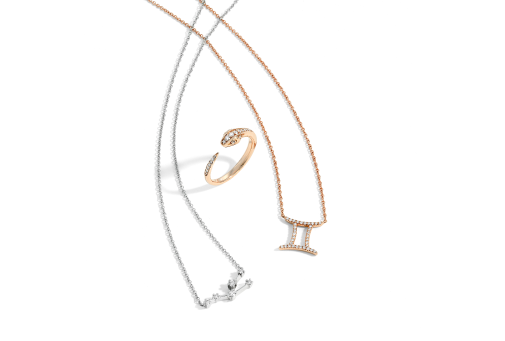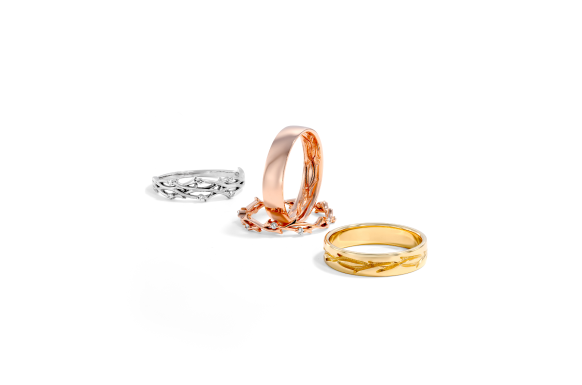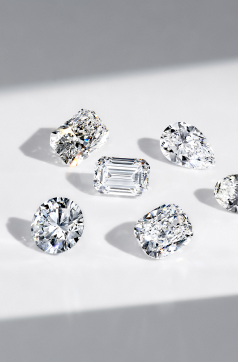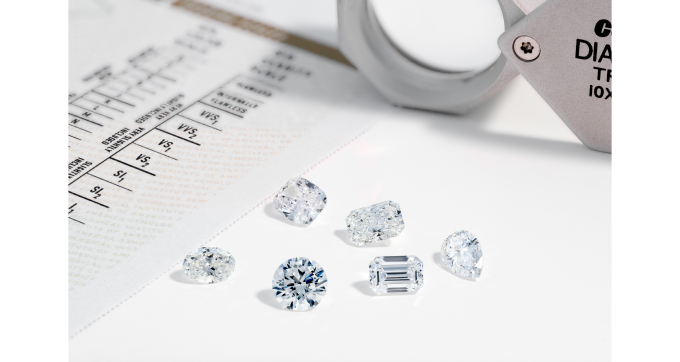Everything You Need to Know About White Gold Engagement Rings
Education Center
Education CenterEverything You Need to Know About White Gold Engagement Rings
White gold is a popular choice for engagement rings. It's got a clean, elegant look that goes with absolutely all clothing colors and skin complexions. We love it. So do couples; white gold is the most popular metal for engagement rings. Here's what you need to know about shopping for white gold and the differences between 14k and 18k. We’ll also cover all things long-term care, including how to clean white gold and replate it (we do this free of charge).
14k vs 18k white gold
When we talk about gold, the karat number refers to purity. 24k gold is 99.9% pure. You would think this is good - but pure gold is so soft it dents and scratches easily. It’s not used in jewelry. Instead, jewelers use 14k and 18k gold: the two types you can buy at Keyzar. The difference between the two can’t be seen with the naked eye. Why?
Because all white gold is rhodium-plated. The rhodium is there to increase white gold’s lifespan and prevent it from scratching or tarnishing. This means what you really see when you look at a ring is rhodium, not the white gold itself. Underneath the rhodium, 14k white gold is a little whiter and more durable. 18k white gold has more of that rich, warm golden hue - but is a little softer. As we already said, though, there’s no visual difference once we plate either alloy.
14k vs. 18k White Gold - What's the Difference?
14k and 18k have a few noticeable differences and a few less obvious ones. Let's compare.
|
14k |
18k |
|
14k has a cleaner white hue underneath the rhodium (58.3% pure gold) |
18k gold has a richer hue underneath the rhodium (75% pure gold) |
|
14k can be a little cheaper |
18k gold is more expensive |
|
14k gold is a little more nick and scratch-resistant |
18k gold is resistant to nicks, scratches, and oxidization |
Caring for White Gold
Because of its rhodium plating, white gold requires a bit more maintenance than rose or yellow gold - but this isn't a bad thing. Rhodium plating creates a strong barrier which helps to prevent dents and scratches. The outer layer is durable and can help protect your ring for longer. It also makes your jewelry shinier, and who doesn't want that?
Cleaning
Here are some tips to clean your ring at home:
- Soak your ring in warm soapy water (make sure to use a very mild soap, NO harsh cleaners)
- Gently wipe dirt off with a soft cloth
- Rinse in lukewarm water
- Dry gently
White gold is delicate. Do not use anything rough or abrasive during the cleaning process. Using strong chemicals and abrasives can damage rhodium plating and set gemstones loose. Deep cleaning should be done by a professional.
Tip: Be sure to remove white gold during any activities that may expose the metals to harsh chemicals. Avoid chlorine in particular, e.g. when swimming, cleaning, etc.
Lifetime Maintenance
White gold is durable and can be brought to a jeweler to buff out any minor scratches. Just be careful; frequent polishing of white gold will cause its rhodium plating to wear down more quickly. Speaking of that plating… It needs to be replaced every few years. You can tell your ring is ready to be dipped when you notice its luster disappearing or you begin to see yellowish patches.
Keyzar offers free polishing and replating on all white gold jewelry purchases for life… So if you want a white gold ring or fine jewelry piece that looks new, consider one of the pieces below:
White gold Vs. Yellow Gold
White gold is more nick and scratch-resistant than yellow gold. It’s also more popular with Keyzar’s customers because of its versatility. It compliments fair and rosy skin tones, but works for all skin colors and tones.
Yellow gold looks great on darker and more olive complexions. It also has a more classic gold look that looks closer to pure 24k gold. Yellow gold is lower-maintenance than white gold. White gold needs to be replated with rhodium once in a while - which you’ll be glad to know we do for free.
Conclusion
14k white gold is stronger than pure gold, less likely to wear than platinum, and is much more affordable than both. And though it may require slightly more maintenance than rose or yellow gold, it remains a clean and classic choice that will last a lifetime.
18k white gold is a beautiful choice for engagement rings. It is rhodium-plated to enhance and preserve its color. When caring for it, make sure to avoid abrasives and strong chemicals. These can easily damage the rhodium plating and the white gold underneath, too.



